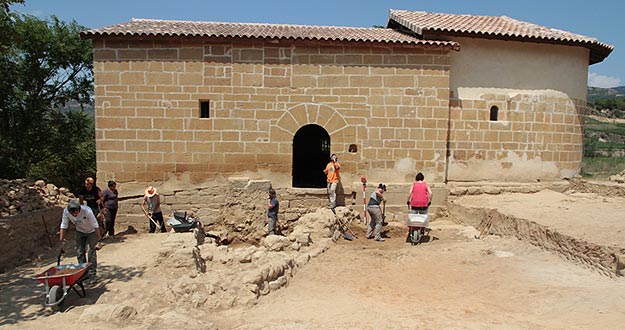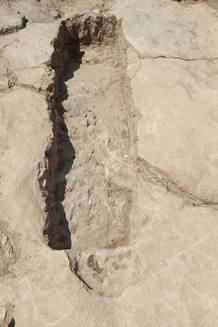I should not like to finish this year without sharing with you a curious news, that I found some months ago: A Medieval village is found in the Rioja of Álava, North east of Spain.
The chapel of Santa Lucia, located in Labastida (Rioja of Alava) hosts an archaeological site, that has been discovered by a research group, at the University of the Basque Country (UPV) and it is the last testimony preserved of an important documented medieval settlement, from the eleventh century.

Domestic and production structures next to the Chapel of Santa Lucia
The first time, that was mentioned this village, situated on the banks of the Ebro, was in a document, from 1075, in which the king of Navarre, Sancho IV, donated the village and the church to the monastery of San Millan, as reported by the UPV .
However, the excavation has shown that the site was occupied previously. The oldest identified witness belongs to an anthropomorphic tomb, excavated in the rock, datable between the ninth and tenth centuries, that is unfinished and could be a part of a larger cemetery, according to the researchers think.

Tomb found by researchers from Heritage and Cultural Landscapes of the UPV
Already, in the twelfth century, the church of Santa María de Torrentejo was built, still preserved, which is mentioned, at the end of this century, as a monastery. However, in the place, there was an earlier temple, which was linked the cemetery, in which reposed Torrentejo neighbors, in the eleventh century.
Then, the village was subjected to a rigid feudal control, both by the Navarre king as by numerous gentlemen, who owned properties, in the place or in the monastery of San Millan de la Cogolla.
Torrentejo was probably abandoned, in the late Middle Ages, like other villages, in the Rioja of Alava. Although, it seems, in this case, the depopulation was quite early, in the thirteenth century.
It was then, when the main towns, organized around castles in the Rioja of Álava, as in the case of Labastida and Laguardia, they manage a group, within its walls, the population of rural areas.
Unlike many other villages of Rioja, Torrentejo had an intense life in Renaissance and modern times.
The excavation has shown the existence of a large number of domestic and productive structures character, appended to the chapel, which shows that the site was occupied intensively during the seventeenth and eighteenth centuries.
Have been found numerous coins, ceramics, food scraps and a trivet, object indicating that, in the place, was manufactured ceramic and it reveals unknown craft activity, in the territory so far.
From the eighteenth century, were conducted several rehabilitation and restoration of the temple. Perhaps one of the most significant took place in 1780-1781.
It is from this point, that the old chapel of St. Mary or Our Lady of Torrentejo begins renamed St. Lucia, a name that has remained until today.
Another major renovation took place in 1866, at the hands of Saturnino Lopez. More recently, the building has been modified, in 1981-1982, and in 2010.
The excavation has also investigated in the vicinity of the shrine and, in the adjacent slopes to the building, were found a series of terraced agricultural use of great antiquity, that analyze some major changes, in the cultural landscape of this area.
In five of them, have been able to observe the existence of several phases of construction, that will determine when the transition occurred from the cultivation of grain and other crops to the extension of monoculture of the vine.
This intervention is very relevant in the context of the recent statement, as a Cultural Asset, by the Basque Government, of the Cultural Landscape Wine and Vineyard of Rioja of Alava, as it will allow, for the first time in this territory, chronicle the process of creating these landscapes cultural.
Well, I hope that you have liked this news such as I do.
Until my next post, kind regards,
Luis.
Sponsored by Costaluz Lawyers.
Please click below:
